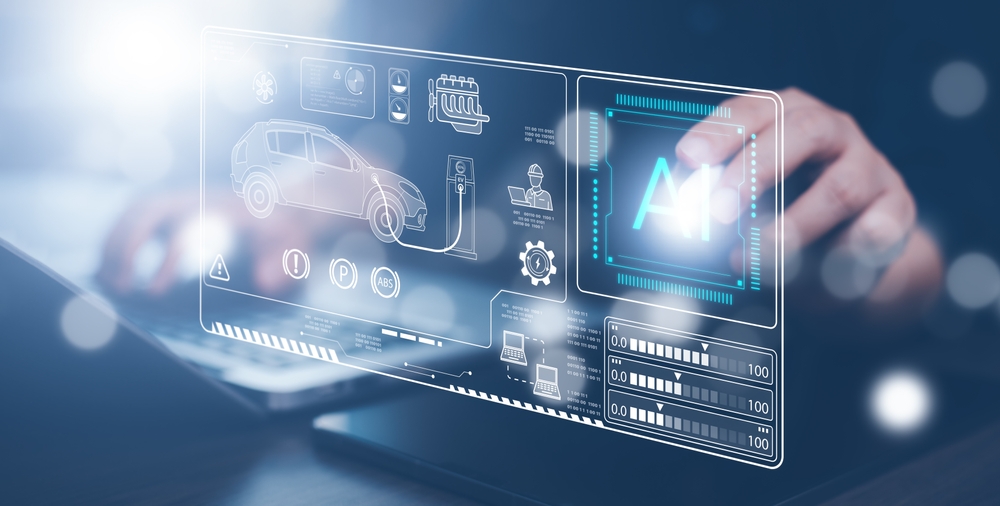AI is becoming increasingly prevalent in our everyday lives, dominating headlines and conversations worldwide.
While forms of Generative AI like ChatGPT grab much of the attention, the technology is much broader than this, with its potential applications seemingly limitless.
AI is already helping us live a more comfortable and convenient home life, powering the businesses we work for and rely upon for vital goods and services, and is starting to become an integral part of the future architectures of the vehicles we drive.
As a leading provider of cybersecurity solutions for the automotive industry, Trustonic is increasingly seeing the influence of AI on vehicle architecture, with a growing number of OEMs seeking to implement AI chips into the cars they manufacture.
This is because these chips are vital for supporting a whole host of sophisticated features designed to enhance the overall driving experience and improve vehicle safety.
In this article, we will explore some of the other biggest AI advances set to shape the automotive sector in 2025 and beyond.
Self-driving advancements
The evolution towards fully autonomous vehicles is one of the most exciting shifts in the automotive industry. While we haven’t yet reached the stage where cars can operate independently in all environments, advancements continue rapidly.
The transition from Advanced Driver Assistance Systems [ADAS] to full autonomy is unfolding gradually, with AI at the core of each milestone.
By the end of 2025, advanced Level 3 solutions will see significant improvements, making commercial deployment more practical. While most current press revolves around autonomous driving using AI, we want to focus on other areas in this blog.
Conversational AI
Having already become a crucial partner for many other industries, conversational AI is now also making waves in automotive, redefining the way drivers interact with their vehicles.
By seamlessly integrating with in-car systems, it enhances functionality, enabling intuitive voice control for navigation, real-time guidance, and various smart features.
Automotive manufacturers use this technology to enhance customer experiences, providing more personalized support and seamless service interactions.
As AI-driven communication continues to evolve, it is set to become an essential component of the modern driving experience.
Predictive maintenance and vehicle health monitoring
Predictive maintenance is also emerging as a game-changer. Using the power of AI algorithms, data analysis and sensors, this technology can forecast when a system or component might fail.
Unlike traditional maintenance, which is either reactive [repairing after failure] or preventive [scheduled checkups], predictive maintenance intervenes precisely when needed, based on real-time conditions. This reduces downtime and repair costs and enhances overall vehicle reliability. T
he technology is particularly impactful in advanced systems, such as Volvo’s cutting-edge engines, where AI-driven diagnostics optimize performance and longevity.
As the industry continues to embrace intelligent cloud-based maintenance, predictive analytics solutions will play a crucial role in enhancing efficiency and sustainability.
AI-based predictive maintenance is currently cloud-based, meaning ever-increasing amounts of data is captured for remote analysis. With the rise of new smaller models, we may see this reversed with more in-vehicle processing, reducing cloud resources needed by OEMs and potentially addressing privacy concerns.
Personalized in-car experiences
AI is also revolutionizing how vehicles adapt to individual needs. Many vehicle manufacturers are now required to include features such as driver attention monitoring – typically powered by AI-driven cameras – to enhance safety. These driver-facing cameras, originally designed for monitoring attentiveness, are often repurposed to identify drivers and personalize their experience seamlessly.
Thanks to machine learning and data analytics, drivers can get into their car and find everything from their seat positioning to the temperature and climate tailored to their own preferences without lifting a finger.
For example, Tesla’s vehicles use AI to analyze individual driver patterns and behaviors, allowing them to automatically adjust various settings such as seat positioning, steering preferences, and suspension dynamics based on each individual’s unique driving style.
BMW has also integrated AI into its vehicles to customize infotainment options according to user preferences, creating a more intuitive and personalized in-car entertainment experience.
Taking things even further, AI can optimize fuel consumption and overall vehicle performance based on individual driving habits, leading to improved efficiency and reduced environmental impact. As a result, drivers can experience cost savings while minimizing their carbon footprint.
AI-powered manufacturing
AI is also being leveraged in manufacturing, enhancing efficiency, precision, and innovation in ways that were once unimaginable.
In 2025, automakers are using AI to streamline production, optimize supply chains, and improve quality control. AI-driven robotics on assembly lines continuously learn and adapt, allowing for faster, more accurate production while working seamlessly alongside human workers.
Predictive maintenance is also being applied in the supply chain and the manufacture of vehicles. Identifying potential equipment failures before they occur, minimizing downtime and improving operational efficiency, extends this value into the factory.
AI enhances supply chain management, predicting demand and automating logistics, leading to better inventory control and reduced waste.
These advancements are making automotive manufacturing faster and more cost-effective and enabling greater customization and sustainability, paving the way for a more dynamic and resilient industry.
Balancing innovation with security
These examples highlight how AI is transforming the automotive industry, driving OEMs to integrate intelligent systems into their vehicle designs. However, AI is also increasing the complexity of in-vehicle software, making it more difficult to assess security and safety with traditional development models.
As AI-driven features become more advanced, they require vast amounts of data to function effectively, raising concerns about data privacy and security. The challenge for manufacturers is not just implementing AI but ensuring these systems remain resilient against potential vulnerabilities while maintaining user trust.
How Trustonic can help
While AI is undoubtedly transforming the automotive industry, its increasing role in vehicle architecture introduces new security challenges that cannot be ignored. At Trustonic, we recognize that as vehicles become smarter, they must also become more secure.
Our Trusted Execution Environment [TEE] technology provides a robust security framework for AI-powered automotive systems. By isolating sensitive processes within a secure environment, the Trustonic TEE protects critical AI functions from cyber threats, ensuring that data integrity, vehicle performance, and driver safety remain uncompromised.
From securing AI-driven diagnostics and critical applications to protecting subsystems, data and in-car personalization features, Trustonic’s advanced security solutions can empower OEMs to harness the full potential of AI while mitigating the associated risks.
As AI continues to reshape the automotive sector, security must be at the forefront of innovation.
Get in touch with Trustonic today to learn how we can help secure the future of AI-powered mobility.

